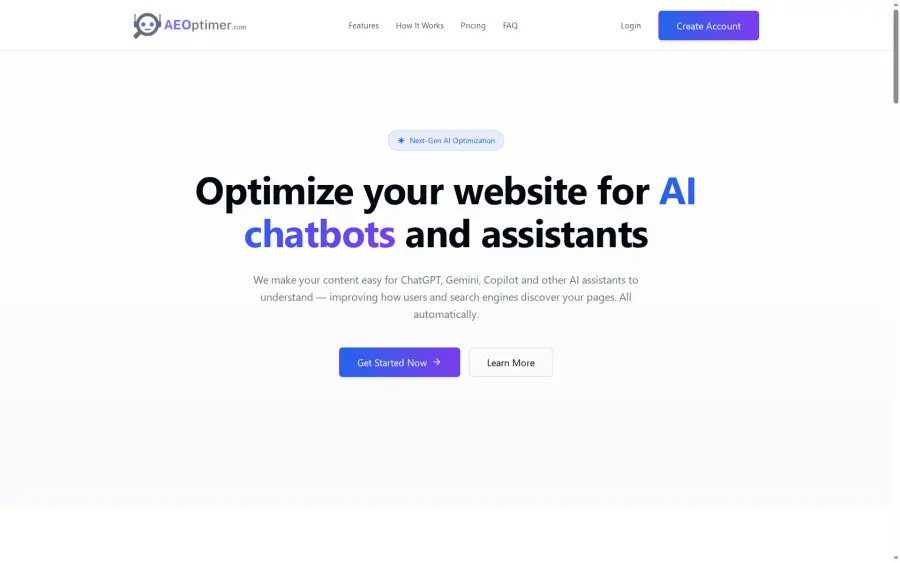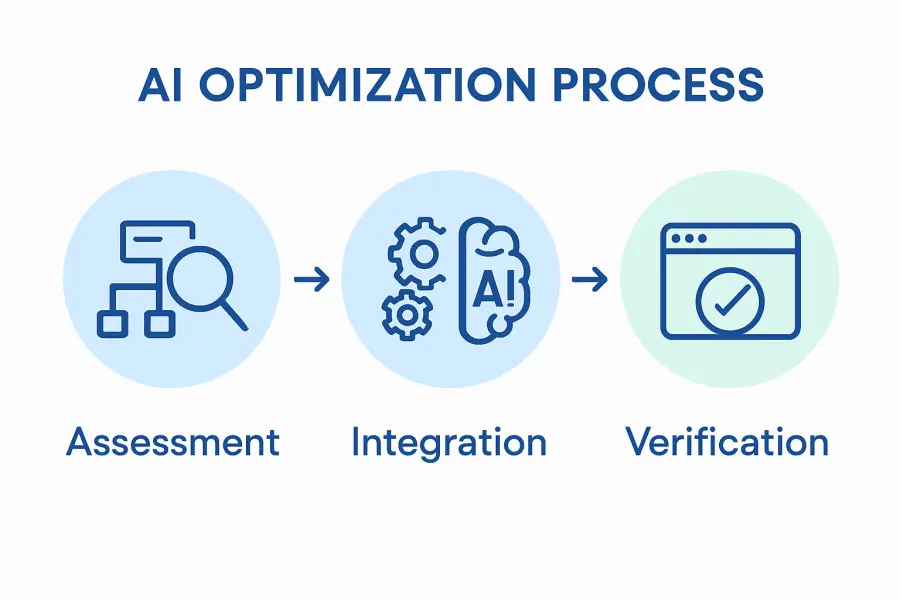Creating AI-Friendly Website Content for Maximum Visibility

Did you know that over 92 percent of online experiences start with a search engine? How your website is structured can make or break its visibility in both classic search and the fast-growing world of AI-driven discovery. Taking smart steps now to optimize your site helps ensure your pages get found while staying relevant as technology evolves. Get ready for strategies that can make your content easier for humans and AI systems to find.
Table of Contents
- Step 1: Assess Existing Website Structure And Content
- Step 2: Integrate Automated AI Optimization Tools
- Step 3: Enhance Pages With Structured Data And Rich Snippets
- Step 4: Update Content To Match Latest AI And Search Trends
- Step 5: Verify AI Discoverability And Search Performance
Quick Summary
| Key Point | Explanation |
|---|---|
| 1. Assess website structure comprehensively | Evaluate site architecture for better AI discoverability and SEO effectiveness, mapping content and technical structure accurately. |
| 2. Integrate AI optimization tools strategically | Choose and implement AI tools in a pilot segment, refining settings based on monitored performance before full-scale use. |
| 3. Enhance content with structured data | Use schema markup to improve content clarity for AI systems, ensuring key pages contain rich snippets for better understanding. |
| 4. Regularly update content for relevance | Conduct audits to refresh outdated content, adapting to new search trends and user behaviors to maintain engagement. |
| 5. Test performance in AI environments | Assess website effectiveness through generative AI platforms, ensuring AI generates accurate representations of your content. |
Step 1: Assess existing website structure and content
In this crucial step, you will evaluate how your current website architecture supports AI discoverability and search engine optimization. Your goal is to create a comprehensive map of your site’s content and technical structure that enables smooth AI crawling and indexing.
Start by creating a comprehensive site inventory. Manually or using a sitemap generator, list every page on your website. According to research from Wikipedia, an adaptive website adjusts its structure based on interactions and requires a clear understanding of existing content. Note each page’s URL, title, content type, and primary topic.
Next, examine your website hierarchy. As insights from Condor suggest, design a logical site structure that supports search engine crawling. Check if your pages are organized in a clear, intuitive manner with logical categories and subcategories. Ensure that important pages are no more than three clicks away from the homepage.
Analyze your content depth and quality. Review each page for:
- Clarity of information
- Relevance to target audience
- Keyword optimization
- Structured data presence
Pro Tip: Use free tools like Google Search Console to understand how search engines currently perceive your website structure.
Finally, identify potential optimization areas. Look for content gaps, outdated information, or pages that could benefit from more comprehensive AI friendly markup. This initial assessment sets the foundation for enhancing your website’s AI discoverability in subsequent steps.
Here’s a summary of key tasks for assessing your website structure and content:
| Assessment Area | Key Actions | Tools/Methods |
|---|---|---|
| Site Inventory | List all pages Document URLs, titles |
Sitemap generator Manual check |
| Website Hierarchy | Review categories Check page nesting |
Site map analysis Hierarchy diagrams |
| Content Quality | Check clarity Ensure relevance Optimize keywords |
Manual review Content audit tools |
| Structured Data | Check for schema Add missing markup |
Structured Data Testing Tool |
| Optimization Areas | Find content gaps Flag outdated info |
Content gap tools Manual inspection |
Step 2: Integrate automated AI optimization tools
In this step, you will learn how to seamlessly integrate AI powered tools that can automatically enhance your website’s discoverability and performance. Your mission is to select and implement smart optimization solutions that work quietly in the background to improve your site’s AI friendliness.
Begin by researching and selecting appropriate AI optimization platforms. According to Benai, implementing AI driven optimization requires a strategic approach. Start with a pilot project by choosing a representative segment of your website to test the tools effectiveness. This allows you to monitor performance and refine parameters before full deployment.
Consider tools that offer comprehensive features like automatic content analysis, structured data generation, and SEO enhancement. Research from MDPI suggests that AI based tools can significantly optimize content management systems by facilitating smarter, more adaptive strategies.
When selecting your AI optimization tool, prioritize platforms that offer:
- Automatic content scanning
- Structured data markup generation
- SEO recommendation updates
- Compatibility with your existing website platform
Pro Tip: Always start with a small website section to test the tool’s impact and accuracy before full implementation.
After selecting your tool, carefully configure its settings to align with your website’s unique requirements. Most AI optimization platforms allow granular control over scanning depth, update frequency, and specific optimization targets. Monitor the initial results closely and be prepared to make incremental adjustments.
The next phase involves tracking the tool’s performance and measuring its impact on your website’s AI discoverability and search engine rankings.
Step 3: Enhance pages with structured data and rich snippets
In this step, you will transform your website content to become more AI friendly by implementing structured data and rich snippets. Your goal is to create clear, machine readable content that helps AI systems understand and interpret your website more effectively.
According to research from Arxiv, Agentic AI Optimization emphasizes the critical importance of integrating structured data to facilitate more effective interactions between websites and autonomous AI systems. Start by identifying the primary content types on your website such as articles, products, events, or services.
Implement schema markup using JSON LD format. This standardized language helps AI understand the context and meaning of your content. Arxiv research suggests that integrating cognitive frameworks can improve content generation and interpretation. Focus on adding specific details like:
- Product prices and availability
- Author information
- Publication dates
- Review ratings
- Business contact details
Pro Tip: Use Google’s Structured Data Testing Tool to validate your markup before implementation.
Prioritize adding schema markup to key pages like your homepage, product pages, and important informational content. Ensure the structured data accurately reflects the visible content on the page to maintain consistency and credibility.
The next phase involves testing and validating your structured data implementation to ensure maximum AI discoverability and search engine understanding.
Step 4: Update content to match latest AI and search trends
In this step, you will learn how to keep your website content dynamic and relevant in the rapidly evolving world of AI and search technologies. Your objective is to continuously adapt your content strategy to align with the latest algorithmic preferences and emerging user search behaviors.
Start by conducting regular content audits. According to research from Arxiv, frameworks like GAIDE demonstrate how generative AI can assist in content development and enhancement. This means staying proactive about updating your existing materials to remain competitive and discoverable.
Monitor key indicators that signal the need for content updates:

- Declining organic search rankings
- Reduced user engagement metrics
- Emerging industry keywords
- New search intent patterns
- Technological shifts in your domain
Leverage AI powered tools to analyze your current content performance. These tools can provide insights into which sections of your website need refinement or complete reconstruction. Arxiv research emphasizes the importance of adaptive content strategies that can quickly respond to changing technological landscapes.
Pro Tip: Set up quarterly content review cycles to ensure your website remains fresh and algorithmically attractive.
Prioritize updating content that directly impacts user experience and search visibility. This might involve rewriting outdated sections, adding current examples, or restructuring information to match emerging search patterns.
The next phase involves implementing your content updates and monitoring their impact on website performance and AI discoverability.
Step 5: Verify AI discoverability and search performance
In this final step, you will thoroughly assess and validate your website’s performance in AI search environments. Your goal is to confirm that all the optimization efforts have transformed your site into a highly discoverable and AI friendly digital resource.
Begin by testing your website across multiple generative AI platforms. According to Wikipedia, KI Search Optimization emphasizes the critical need for strategies that influence how AI models retrieve and present information. Conduct comprehensive searches using platforms like ChatGPT, Google Gemini, and Microsoft Copilot to understand how your content appears in AI generated results.
Utilize specialized AI discoverability testing tools to analyze your website’s performance. Research from Arxiv highlights the necessity of optimizing websites for interactions with autonomous AI agents. Focus on metrics such as:
- Content retrieval accuracy
- Context preservation
- Relevance scoring
- Information extraction capabilities
- Snippet generation quality
Pro Tip: Create a standardized test query set that represents your target audience’s typical search behaviors to ensure comprehensive evaluation.
Review the AI generated responses for accuracy, completeness, and alignment with your original content. Pay special attention to how AI systems interpret and summarize your website information. Look for potential misunderstandings or areas where your content could be more precisely structured.
Remain prepared to iterate and refine your optimization strategy based on these insights. Your ongoing commitment to understanding and adapting to AI search technologies will ensure your website remains competitive and discoverable.
Boost Your Website’s AI Discoverability with Ease
Creating AI-friendly website content is essential to stay visible in the fast-evolving world of AI search and assistants. The article highlights challenges like implementing structured data, updating content dynamically, and ensuring your site is easily crawlable by AI systems like ChatGPT and Gemini. These tasks can feel overwhelming especially without technical expertise or dedicated resources.
aeoptimer.com is designed to solve these exact problems by automating your website optimization. With features such as automatic sitemap detection, monthly content updates, and seamless integration of AI-friendly enhancements, it lets you focus on your business while ensuring your website meets the latest AI and search engine standards. Discover how aeoptimer.com works to keep your content relevant and highly discoverable by AI assistants.

Don’t let your website fall behind in AI discoverability. Take control now by signing up for aeoptimer.com and start experiencing continuous AI-ready optimization with zero technical hassle. Explore our platform and unlock the power of automated AI optimization today to keep your content visible where it matters most.

Frequently Asked Questions
How can I assess my website’s existing structure for AI discoverability?
Begin by creating a comprehensive inventory of all pages, including their URLs, titles, and content types. Use a sitemap generator or manually document this information to understand your site’s current architecture, then evaluate if important pages are easy to access.
What steps should I take to integrate AI optimization tools on my website?
Research and select AI optimization platforms that fit your website’s needs. Start by running a pilot project on a small section of your site to test the tool’s effectiveness, then monitor its performance before rolling out to the entire website.
How do I implement structured data to improve my website’s AI compatibility?
Focus on using JSON-LD format to add schema markup specific to your content types, such as articles or products. Implement structured data on key pages and validate it using a structured data testing tool to ensure accuracy and maximize discoverability.
What should I monitor to keep my website content updated for AI searches?
Regularly conduct content audits to assess performance metrics like organic search rankings and user engagement. Update your content in response to emerging keywords and search intent patterns to stay relevant and maintain visibility in AI-generated results.
How can I verify my website’s performance in AI search environments?
Test your website across multiple generative AI platforms like ChatGPT or Google Gemini to assess how your content appears in AI results. Analyze metrics such as content retrieval accuracy and relevance scoring to identify areas for further optimization.





